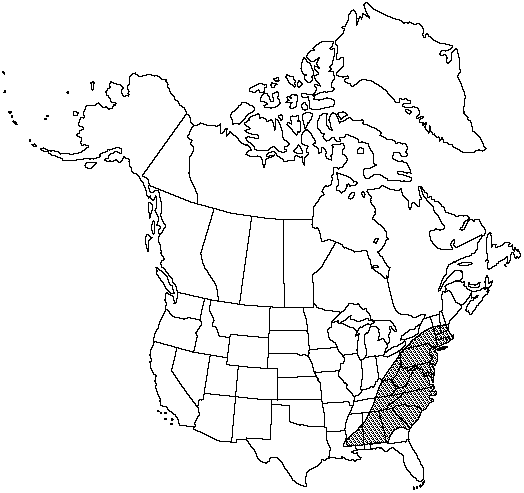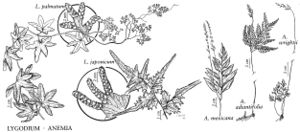Lygodium palmatum
Syn. Fil. 154. 1806.
Stems long-creeping. Leaves to ca. 3 m. Petioles borne 1-4 cm apart, 9-15 cm. Sterile pinnae on 1-2 cm stalks, very broadly ovate, deeply and palmately 3-7-lobed, 1-4 × 2-6 cm; ultimate lobes triangular-elongate to oblong; lobe apex acute to blunt or rounded; segments not articulate to petiolules, not leaving wiry stalks when detached; blade tissue pubescent abaxially with transparent hairs. Fertile pinnae stalked to ca. 1.5 cm, then ± irregularly 3-5-forked or lobed, ultimate divisions palmately and sometimes irregularly lobed, smaller than sterile pinnules, 2-4 × 2-8 cm, otherwise similar; ultimate segments narrowly triangular to linear-triangular.
Habitat: Terrestrial in woods, thickets, and bog margins in humus-rich, acid soils.
Distribution

Ala., Conn., Del., Ga., Ky., Maine, Md., Mass., Miss., N.H., N.J., N.Y., N.C., Ohio, Pa., R.I., S.C., Tenn., Vt., Va., W.Va.
Discussion
Lygodium palmatum is generally local and rare except for the Cumberland Plateau of Kentucky and Tennessee where it is locally abundant in poorly drained, acidic soils, especially after disturbance (J. M. Shaver 1954; R. Cranfill 1980). Other authors have reported this species from Florida (O. Lakela and R. W. Long 1976), but I have not seen specimens (C. E. Nauman 1987). This species is not tolerant of shading.
Selected References
None.
